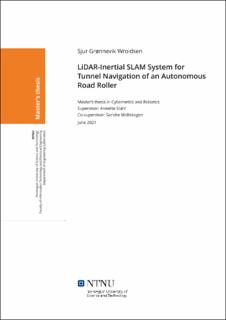| dc.contributor.advisor | Stahl, Annette | |
| dc.contributor.advisor | Midtskogen, Sondre | |
| dc.contributor.author | Wroldsen, Sjur Grønnevik | |
| dc.date.accessioned | 2021-10-05T17:37:43Z | |
| dc.date.available | 2021-10-05T17:37:43Z | |
| dc.date.issued | 2021 | |
| dc.identifier | no.ntnu:inspera:76427839:45138288 | |
| dc.identifier.uri | https://hdl.handle.net/11250/2787892 | |
| dc.description.abstract | Autonom drift kan redusere menneskelig utsettelse mot farlige miljøer. Det kan også forbedre tids- og kostnadseffektiviteten ved at en menneskelig operator kan operere flere autonome kjøretøyer på en gang uten å være fysisk tilstede. Dette er gunstig for mange industrier, deriblant for veikonstruksjon. Denne avhandlingen
ser på problemet om autonom operasjon av en veivals. Autonom operasjon krever robuste systemer for navigasjon. Tradisjonelt er slike systemer avhengige av å kombinere treghetssensorer med globale satelittsystemer for navigasjon (GNSS) for å holde estimatene globalt konsistente. I situasjoner med dårlig satelittdekning vil derimot slike systemer ha en tendens til å opparbeide drift.
For å minske denne driften blir sensorer som kamera eller laserskannere (LiDAR)
ofte brukt. Denne avhandlingen foreslår et simpelt ‘feature’-basert LiDAR-Inertial
SLAM system som fusjonerer sensorinformasjon fra en IMU, en LiDAR og en GNSS
mottaker for tunnelnavigasjonsproblemet.
Systemet blir deretter evaluert på to ulike simulerte scenarioer. Til forfatterens kjennskap eksisterer det ingen datasett til denne applikasjonen. Derfor ble det i forprosjektet utviklet en simulator i MATLAB. Simulatoren blir i denne avhandlingen utvidet til å inkludere en IMU og GNSS. Resultatene viser at LiDAR-Inertial SLAM-systemet klarer å oppnå et bra estimat av posisjonen sin i planet, noe som resulterer i en Root Mean Square Error (RMSE) på 3.12m på en tur-retur bane gjennom tunnelen. Standarden for dokumentasjon av kompresjon av materiale sier at posisjonen må kunne måles med en nøyaktighet på ±0.2m. Etter disse standardene presterer ikke systemet bra nok. Resultatene viser videre at systemet undervurderer kovariansen, noe som gir en Average Normalized Estimation Error Squared (ANEES) på 9.85, der 95% konfidensintervallet tilsier at den skulle lagt innenfor intervallet [2.65, 3.37]. Disse resultatene ble tatt etter ‘glattingen’ har forekommet når veivalsen forlater tunnelen for siste gang. | |
| dc.description.abstract | Autonomous operation can reduce human exposure to hazardous environments. Additionally, it can improve time- and cost-effectiveness since several autonomous vehicles can be operated by a single operator without being physically present. This is favorable for many industries, among others the road construction industry. The problem of autonomous operation of a road roller is the subject of study in this thesis. Autonomous operation requires robust systems for navigation. Typically navigation systems rely on inertial sensors aided by measurements from Global Navigation Satellite System (GNSS) to keep their estimates globally consistent. In the case of poor satellite coverage, however, these navigation systems tend to drift quickly.
To help mitigate this drift, exteroceptive sensors such as a camera and/or a Light Detection and Ranging (LiDAR) sensors are typically used. This thesis proposes a simple feature-based LiDAR-Inertial Simultaneous Localization and Mapping (SLAM) system. The system fuses information from a LiDAR, an Inertial Measurement Unit (IMU), and a GNSS receiver for the problem of tunnel navigation.
The performance of the system is then evaluated on two simulated scenarios. To
the author’s knowledge, there exist no simulated data sets for this particular application. Therefore a simulation environment was constructed in the pre-project. This framework is extended to include inertial sensors and GNSS in this thesis. The results show that the LiDAR-Inertial SLAM system can provide a reasonable estimate of its position, producing a Root Mean Square Error (RMSE) of 3.12m on a trajectory performing a round trip going through the tunnel before turning and traversing back through the same tunnel. However, the required standard for documentation states that position must be guaranteed within ±0.2m, so the performance is not in compliance with the standard. The results do further show that the system underestimates its covariance, giving an Average Normalized Estimation Error Squared (ANEES) of 9.85 with the 95% confidence bounds of [2.65, 3.37]. The results were achieved after smoothing when returning to the start position after re-exiting the tunnel. | |
| dc.language | eng | |
| dc.publisher | NTNU | |
| dc.title | LiDAR-Inertial SLAM System for Tunnel Navigation of an Autonomous Road Roller | |
| dc.type | Master thesis | |
